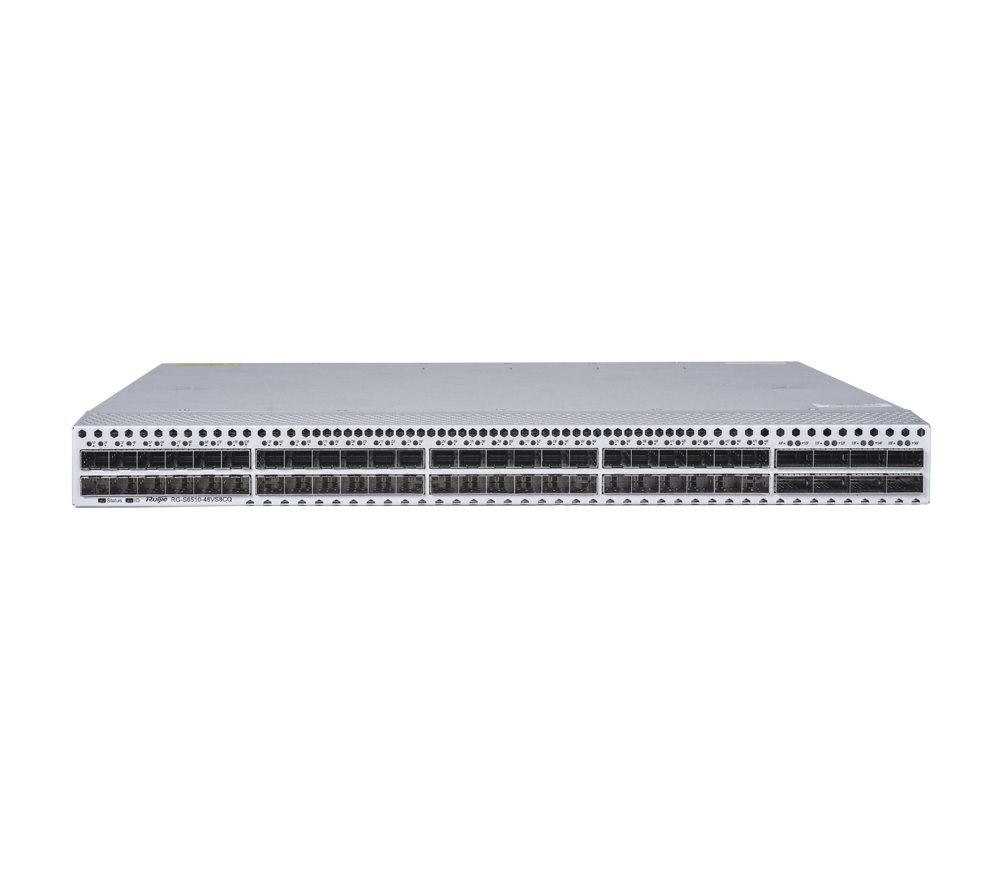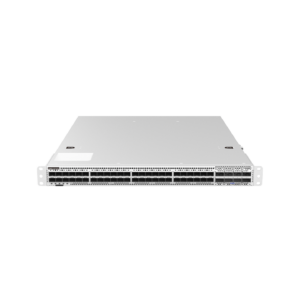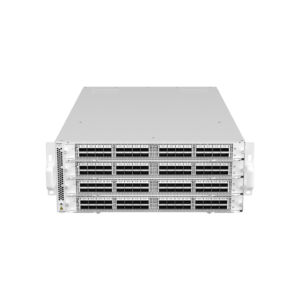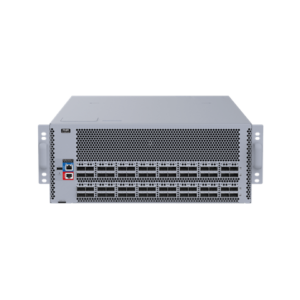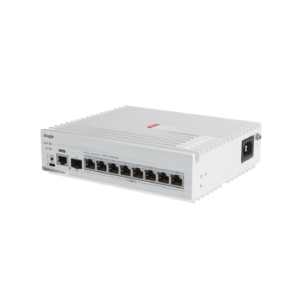Non-blocking Data Center Networks and Powerful Cache Capacity
The whole series of switches oriented towards next-generation data centers and cloud computing are line-rate products. They are in line with the development trend of East-West traffic of data centers and apply to heavy-traffic next-generation data centers. They meet the Spine-Leaf network architecture design requirements.
The RG-S6520 series switches provide a maximum of 64 x 100GE ports. All the ports can forward data at the line rate.
To meet the requirements for unblocked transmission of heavy-traffic data in data centers, the switch offers powerful cache capacity and uses the advanced cache scheduling mechanism, to ensure that the cache capacity of the switch is effectively leveraged.
Data Center Virtualization
The RG-S6520 series switches adopt the virtual switching unit (VSU) 2.0 technology to virtualize multiple physical devices into one logical device, which reduces network nodes and enhances network reliability. These physical switches can be operated and managed in a unified manner. The switch can implement fast link switching within 50 ms to 200 ms in the case of a link failure, thereby ensuring the uninterrupted transmission of key services. The inter-device link aggregation feature implements dual active uplinks for data through access servers and switches.
RDMA-based Lossless Ethernet
The switch implements low-delay forwarding of the lossless Ethernet based on the Remote Direct Memory Access (RDMA) and optimizes service forwarding performance. It greatly reduces the operation cost per bit of the entire network and enhances the competitive edge of products.
Hardware-based Traffic Visualization
The chip hardware enables the switch to visualize the end-to-end traffic of complex networks involving multiple paths and nodes. Then, users can focus on monitoring the forwarding path and delay of each session, dramatically raising the troubleshooting efficiency.
Carrier-Class Reliability Protection
The switch is equipped with built-in redundant power supply modules and modular fan assemblies. All power supply modules and fan modules can be hot-swapped without affecting the normal running of the switch. The switch provides fault detection and alarm functions for power supply modules and fans. It automatically adjusts the fan speed based on temperature changes, to better adapt to the environment in data centers. The switch also supports device-level and link-level reliability protection as well as overcurrent protection, overvoltage protection, and overheating protection.
In addition, the switch integrates various link reliability mechanisms such as Rapid Ethernet Uplink Protection Protocol (REUP), quick link switching, graceful restart (GR), and bidirectional forwarding detection (BFD). When multiple services and heavy traffic are carried over the network, these mechanisms can reduce the impact of exceptions on network services and enhance overall reliability.
IPv4/IPv6 Dual-Stack Protocols and Multilayer Switching
The hardware of the RG-S6520 series switches supports IPv4 and IPv6 protocol stacks and multilayer line-rate switching. The hardware differentiates and processes IPv4 and IPv6 packets. The switch also integrates multiple tunneling technologies such as manually configured tunnels, automatic tunnels, and Intra-Site Automatic Tunnel Addressing Protocol (ISATAP) tunnels. Users can flexibly work out IPv6 inter-network communication solutions by using this switch based on IPv6 network planning and network conditions.
The RG-S6520 series switches support numerous IPv4 routing protocols, including static routing, Routing Information Protocol (RIP), Open Shortest Path First (OSPF), Intermediate System to Intermediate System (IS-IS), and Border Gateway Protocol version 4 (BGP4). Users can select required routing protocols based on network environments, to flexibly build networks.
The RG-S6520 series switches also support abundant IPv6 routing protocols, including static routing, Routing Information Protocol next generation (RIPng), OSPFv3, and BGP4+. Appropriate routing protocols can be selected to upgrade an existing network to an IPv6 network or build a new IPv6 network.
Flexible and Complete Security Policies
The RG-S6520 series switches effectively defend against and control virus spread and hacker attacks by using multiple inherent mechanisms such as anti-DoS attack, anti-IP scanning, validity check of ARP packets on ports, and multiple hardware ACL policies.
The hardware-based IPv6 ACL can easily control the access of IPv6 users at the network boundary even if there are IPv6 users on an IPv4 network. The switch supports the coexistence of IPv4 and IPv6 users and can control access permissions of IPv6 users, for example, restricting access to sensitive resources on the network.
The telnet access control based on source IP addresses can prevent illegitimate users and hackers from maliciously attacking and controlling the switch, enhancing network management security. The Secure Shell (SSH) and Simple Network Management Protocol version 3 (SNMPv3) can encrypt management information in the telnet and SNMP processes, thereby ensuring the information security of the switch and preventing hackers from attacking and controlling the switch.
The switch rejects network access from illegitimate users and enables legitimate users to use networks properly by employing multi-element binding, port security, time-based ACL, and data stream–based rate limit. It can strictly control user access to enterprise networks and campus networks and restrict the communication of unauthorized users.
All-Round Management Performance
The switch provides various management interfaces such as the console interface, management interface, and USB interface, and supports Simple Network Management Protocol (SNMP) v1/v2/v3 and universal network management platform. It supports CLI-based management, telnet, and cluster management, which facilitates device management. The supported encryption modes such as SSH2.0 and SSL ensure more secure management.
In addition, the switch supports the Switched Port Analyzer (SPAN)/Remote Switched Port Analyzer (RSPAN) and multiple SPAN monitoring ports. It can analyze network traffic and take proper management and maintenance measures accordingly, clearly presenting the service traffic on a network. The switch can provide various network traffic analysis reports so that users can optimize the network structure and adjust resource deployment in a timely manner.

